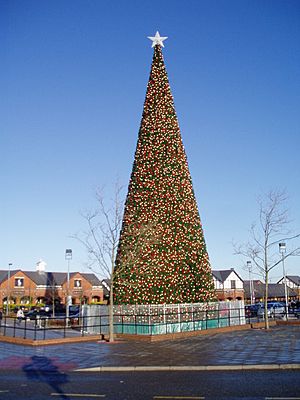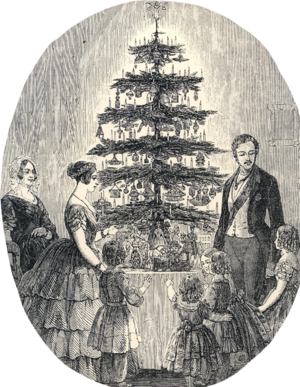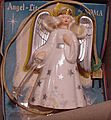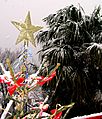Tree-topper facts for kids
A tree-topper is a special decoration placed on the very top of a Christmas tree. These ornaments come in many shapes and sizes. The most common ones are stars, angels, or fairies.
Other popular tree-toppers include Santa Claus, ribbon bows, or even owls and white doves. They can be made from many different materials. Some modern tree-toppers are electric. They can light up when connected to the tree's lights, giving a soft glow. After World War II, electric tree-toppers shaped like Santa Claus became very popular.
Contents
Why We Use Tree-Toppers
Many people choose an angel as their tree-topper. This often represents the angel Gabriel. In the Christian story, Gabriel told Mary she would have a special baby, Jesus.
A star is another very common tree-topper. This star represents the Star of Bethlehem. In the Christian story, this star guided wise men to where Jesus was born.
The idea of using an angel on top of a Christmas tree became popular during the Victorian era. This was when Christmas trees started to become very common in England. A famous picture from 1848 showed Queen Victoria, Prince Albert, and their family with an angel on their Christmas tree. This helped make the angel a popular choice.
Today, stars are often the most popular tree-topper. A survey in the United States found that about 39% of people use a star. About 23% use an angel.
Other Tree-Topper Ideas
Some families celebrate the winter solstice. This holiday happens around the same time as Christmas. They decorate an evergreen tree to show that life continues even in winter. These families might choose tree-toppers that are not Christian symbols. For example, they might use a symbol of the sun.
Tree-Toppers in Stories and Songs
Tree-toppers appear in many stories and songs. In Hans Christian Andersen's story "The Fir-Tree" (written in 1844), a Danish Christmas tree is described. It has a "large star of gold tinsel" at the very top.
Christmas songs also mention tree-toppers. For example, the Swedish song "Först en stjärna utav gull" means "First a star of gold." The song "Have Yourself a Merry Little Christmas" also says, "So hang a shining star upon the highest bough."
Image Gallery
See also






